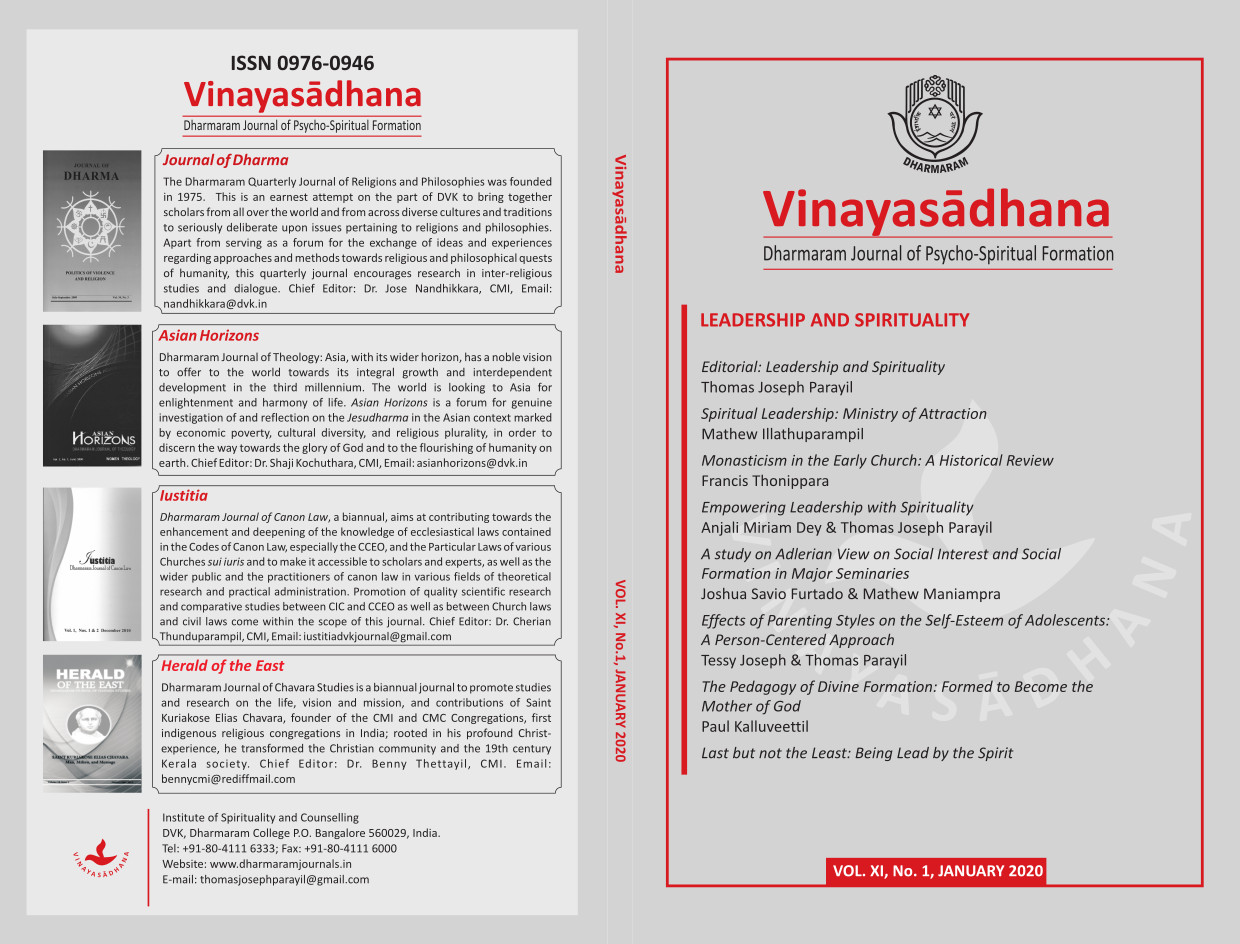A study on Adlerian View on Social Interest and Social Formation in Major Seminaries
Keywords:
Social Formation, Seminary, Social Interest, Social Consciousness, VocationAbstract
According to Adler, it is only through an interest in fellow human beings that all the progress in the world has been made. The concerns of the present world call for a renewed and reformed way of formation in seminaries. An empirical study was conducted to understand the present state of social interest in the seminaries. The results indicate that the development of social interest does help the seminarians in enhancing their vocational consciousness, helps in having vocational fulfilment, and also in the seminary formation process. Adler’s concept of ‘social interest’ shows how the social feeling is so much integral to the seminarian’s ‘meaning’ and vocation in life.
References
Adler, A. (1958). What life should mean to you. New York: Capricorn Books.
Adler, A. (1964). Superiority and social interest: A collection of later writings. USA: Northwestern University Press.
Adler, A. (1965). Understanding human nature. New York: Faucett Publication.
Adler, A. (1969). The science of living. New York: Double Day and Company.
Alackapally, S. (2019). Holistic formation and ethical harmony of person: Collected works of Dr Thomas Manickam, CMI. Bangalore: Dharmaram Publication.
Catholic Bishops’ Conference of India. Charter of priestly formation for India. Madras: Catholic Bishops’ Conference of India, 1988.
Chethimattam, J. B. (1984). An Indian seminary curriculum: Why and what for? Jeevadhara, 14, 255–269.
Cohen, J. (1988). Statistical power analysis for the behavioral sciences, New York: Routledge.
Congregation of the Clergy. (8th December 2016). Ratio FundamentalisInstitutionisSacerdotalis, 2016.Vatican City: L’Osservatore Romano.
Ellis, J. T. (1967). Essays in seminary education, Notre Dame: Fides Publishers.
Feist, J., Feist, G. J., & Robets, T–A. (2013). Theories of personality. United States: McGraw Hill.
Heath, W. (2018). Psychology research methods. New Jersey: Cambridge University Press.
Ignatius, M. J. (February 2019). Social commitment of the Catholic Church in India. Socially oriented formation in major seminaries – Seminar Cum Workshop, Dharmaram, Bengaluru.
John Paul II. (1992). Post–Synodal Apostolic Exhortation, PastoresDaboVobis. 1992. AAS 84, 657–804.
John Paul II. (1996). Post–Synodal Apostolic Exhortation, Vita Consecrata, 1996. AAS, 88, 377–503.
John XXIII. (1961). Encyclical letter, Mater etMagistra, 1961. AAS, 53, 401–464.
John, T. K. (2006). Decolonization of Formation. In K. Kunnumpurm (Eds.), Shaping tomorrow’s Church: Formation of Priests and Religious for India, 200–219. Mumbai: St. Paul’s Publication.
Karokaran, A. (1983). Seminary formation in the context of the struggles of the Indian Masses. Indian Missiological Review, 3, 216–219.
Lee, J. M., & Louis, J. P., (Eds.). (1965). Seminary education in a time of change. Notre Dame: Fides Publication.
Lendakadavil, A. (2011). Candidates for priesthood. Shillong: Vendrame Institute Publication.
Maniampra, M. (2019). Psycho-theological paradigms in Saint Kuriakose Elias Chavara. Bangalore: Dharmaram Publication.
Manickam, T. (1984). Seminary training in India today: A critique. Jeevadhara, 14, 270–282.
Padinjarekuttu, I. (2006). Priestly formation: Historical perspectives. In K. Kunnumpuram (Eds.), Shaping tomorrow’s church: Formation of Priests and Religious for India, 142–174. Mumbai: St Pauls Publication.
Parappally, J. (2006). Formation of the Religious: Challenges of Vatican II and Post-Conciliar times. In K. Kunnumpurm (Eds.), Shaping tomorrow’s Church: Formation of Priests and Religious for India, 175–199. Mumbai: St. Paul’s Publication.
Parathazham, P. (1988). Catholic Priests in India: Reflections on a survey. Vidyajyoti, 8, 382–391.
Paul VI. (1971). Apostolic Exhortation, EvangelicaTestificatio, 1971. AAS, 63, 497–526.
Paul VI. (1976). Apostolic Exhortation, EvangeliiNuntiandi, 1975. AAS, 68, 5–77.
Pope Francis. (2013). Apostolic Exhortation, EvangeliiGaudium. AAS, 105, 1019–1137.
Pope Francis. (8th July 2013). Homily. Roma: LibreriaEditriceVaticana.
Puthiadam, I. (2003). Religious life and maturity. Bangalore: Asian Trading Corporation.
Richardson, J. (1987). Work and the life of meaning: The relevance of Alfred Adler. Cross Currents, 4, 416–426.
Schultz, D. P., & Sydney, E. S. (2005). Theories of personality. USA: Wordsworth Thomson Learning.
Soares, P. G. (1992). Christian Priesthood in India today: A Biblical reflection. Vidyajyoti, 6, 83–89.
Thonippara, F. (2015). Priestly and Religious formation in the Catholic Church: A historical perspective. Vinayasadhana, 6(1), 57–76.
Vallipalam, M. M. (1989). Priestly Formation in the changing society of India. Bombay: St. Paul Publications.
Vatican Council II. (1964). Dogmatic constitution of the church: Lumen Gentium, 1964. AAS 57, 5–71.
Vatican Council II. (1966a). Decree on Priestly Training: OptatamTotius, 1965. AAS 58, 713–727.
Vatican Council II. (1966b). Decree on the Church’s missionary activity: Ad GentesDivinitus, 1965. AAS 58, 1080–1081.
Vatican Council II. (1966c). Decree on the ministry and life of the Priest: PresbyterorumOrdinis, 1965. AAS 58, 991–1185.
Vatican Council II. (1966d). Pastoral constitution of the church in the modern world: Gaudium et Spes, 1965. AAS 58, 1025–1170.
Wagenhofer, J. P. (1995). Spiritual leadership: A matrix for ministerial education. In R. J. Wicks (Eds.), Handbook of spirituality for ministers, 531–544. New York: Paulist Press.


